When it comes to healthier, hassle-free cooking, ceramic-coated pans have become a favorite in kitchens everywhere. Unlike traditional nonstick cookware that relies on chemical coatings such as Teflon, ceramic-coated pans use a mineral-based layer that delivers easy food release, quick cleanup, and excellent heat distribution—without the worry of harmful toxins. Whether you’re flipping eggs, searing vegetables, or preparing delicate fish, the best ceramic-coated pans offer a slick, durable surface that elevates everyday cooking.
But with so many brands claiming to be the smoothest, safest, or longest-lasting, choosing the right pan can be overwhelming. This guide breaks down the key features to look for so you can confidently pick a ceramic-coated pan that performs beautifully in your kitchen and stands the test of time.
Buying Guide: How to Choose the Best Ceramic-Coated Pan
1. Type of Ceramic Coating
Ceramic coatings come in different forms, but most high-quality pans use a sol-gel mineral coating, known for being naturally nonstick and PTFE/PFOA-free. Look for brands that clearly state their coating is free from harmful chemicals and heavy metals.
2. Base Material
The metal base beneath the coating determines heat retention and durability:
- Aluminum – Lightweight, heats quickly and evenly; most common.
- Hard-anodized aluminum – Stronger and more durable than standard aluminum.
- Stainless steel – Offers excellent longevity and stability but may take longer to heat.
Choose based on the balance of weight, performance, and durability you prefer.
3. Thickness and Build Quality
Thicker pans resist warping and maintain heat better. For daily cooking, aim for a pan with a medium to heavy-gauge construction. Warping can compromise the nonstick surface and make the pan wobble on your stove.
4. Handle Comfort and Safety
Consider the ergonomics:
- Stay-cool handles are ideal for safety.
- Stainless steel handles are durable but may heat up.
- Silicone-wrapped handles offer comfort and grip.
If you often transfer pans from stove to oven, ensure the handle is oven-safe to the temperatures you need.
5. Oven-Safe & Dishwasher-Safe Ratings
Not all ceramic-coated pans can withstand high oven temperatures—some are safe up to 350°F, while premium models go up to 500°F or more.
While many pans claim to be dishwasher-safe, handwashing is always recommended to preserve the coating’s lifespan.
6. Compatibility With Your Cooktop
Check if the pan works with your cooker:
- Most ceramic pans work on gas and electric stoves.
- If you have induction, ensure the pan has a magnetic steel base.
7. Durability & Scratch Resistance
Ceramic coatings are smooth but can scratch if mishandled. If durability is important:
- Look for multi-layer coatings.
- Choose pans that advertise enhanced abrasion resistance.
- Avoid using metal utensils to extend the life of the coating.
8. Weight and Maneuverability
A pan that’s too heavy becomes difficult to flip or pour from, while one too light may feel flimsy. The best ceramic-coated pans strike a balance—solid enough to heat evenly but light enough for everyday use.
9. Lid Quality
If buying a lidded skillet or sauté pan:
- Tempered glass lids let you monitor food without lifting them.
- Vent holes help reduce steam buildup.
10. Warranty & Brand Reputation
A reliable warranty reflects a manufacturer’s confidence in the product. Established cookware brands usually offer:
- Better coating technology
- Stronger materials
- More responsive customer service
Look for companies with proven quality and positive user feedback.
1. OXO Enhanced 10″ Ceramic Frying Pan
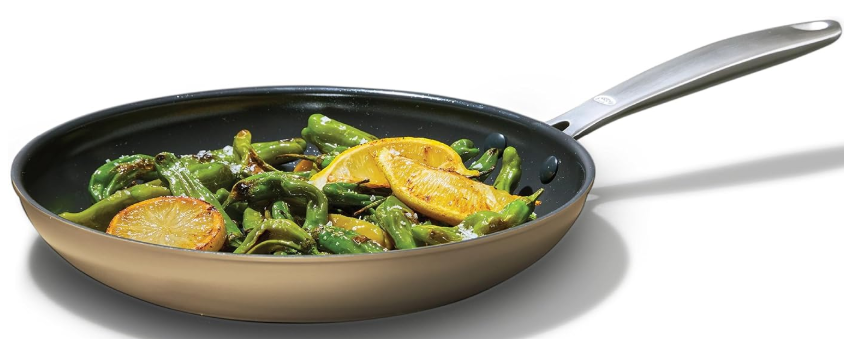
Product Description
The OXO Enhanced 10″ Frying Pan is a well-built hard-anodized aluminum skillet designed to deliver dependable cooking performance. Its ceramic nonstick interior is reinforced with diamond particles to improve durability and food release. Built for both safety and convenience, the pan’s coating is free from PFAS, PFOA, lead, and cadmium, making it a healthier choice for everyday cooking. A stainless steel handle offers a secure grip, and the pan is dishwasher safe for easy cleanup. It’s oven-safe too, offering good versatility for finishing dishes in the oven.
Key Features
- Diamond-reinforced ceramic nonstick coating (PFAS-free, PFOA-free) (Amazon)
- Hard-anodized aluminum body for even, fast heating (Amazon)
- Scratch-resistant, seamless interior with no food-trapping rivets (Amazon)
- Oven safe (manufacturer lists up to 600°F for similar models) (Amazon)
- Dishwasher safe for convenient cleanup (Amazon)
- Cool stainless-steel handle for secure, comfortable handling (Amazon)
Pros
- Excellent nonstick performance: food slides off easily, reducing need for oil
- Durable coating thanks to the diamond reinforcement
- Versatile: works on stovetop and can go into the oven
- Easy to clean by hand or in the dishwasher
- Well-balanced and comfortable to hold
Cons
- Hard-anodized aluminum may feel heavier compared to thin pans
- Although stronger, ceramic coatings still degrade with time, especially with high heat or metal utensils
- Premium price point relative to basic nonstick pans
Recommendation
This pan is a great choice for home cooks who want a durable, high-performance ceramic skillet with a healthy, toxin-free coating. Use it for everyday frying, sautéing, or finishing dishes in the oven. Ideal if you’re willing to invest a bit more for longevity and nonstick reliability.
2. Blue Diamond 8″ Ceramic Nonstick Frying Pan
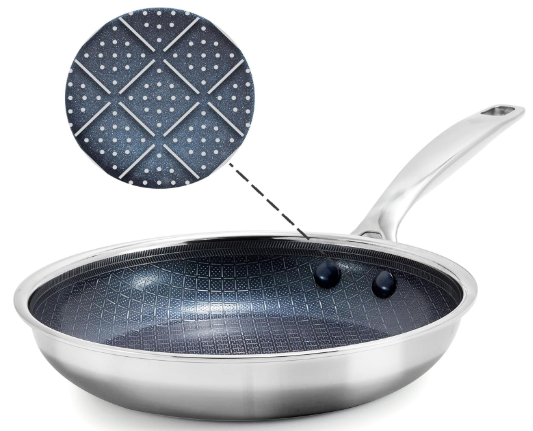
Product Description
This compact 8-inch skillet from Blue Diamond is infused with diamond particles in its ceramic coating, making it tougher and more scratch-resistant than typical nonstick pans. Its body is forged heavy-gauge aluminum, which ensures even heat distribution and resists warping over time. The coating is free from PFAS, PFOA, lead, and cadmium. With a riveted stainless steel handle, the pan provides a secure grip. It’s also oven- and broiler-safe, making it versatile for different cooking tasks.
Key Features
- Diamond-infused ceramic nonstick surface: 5× harder and long-lasting (KitchnAndDining.com)
- PFAS-, PFOA-, lead-, and cadmium-free coating (KitchnAndDining.com)
- Heavy-duty forged aluminum body for durability and efficient heat transfer (KitchnAndDining.com)
- Warp control base to maintain shape and prevent wobble or degradation (KitchnAndDining.com)
- Oven / broiler safe (manufacturer states very high temp tolerance) (walmart.com)
- Dishwasher safe for easy cleanup
Pros
- Very durable nonstick surface: can withstand metal utensils to some extent
- Compact size is ideal for small meals (eggs, omelets)
- Excellent heat distribution and retention
- Affordable and lightweight for daily use
- Safe, chemical-free coating
Cons
- Not induction-compatible (standard aluminum base)
- Though tough, the coating will still wear over time, especially with rough handling
- Smaller size may not be ideal for large batches
Recommendation
This is perfect for a budget-friendly, everyday skillet that handles basic tasks like eggs, sautéing, or quick searing. Its durable diamond-ceramic coating gives you more resilience than typical Teflon-style pans, making it a strong value pick.
3. GreenLife Soft Grip 10″ Ceramic Frying Pan

Product Description
The GreenLife Soft Grip 10″ Frying Pan features a ceramic nonstick coating derived from sand, ensuring a free-of-toxic-chemicals cooking surface (no PFAS, PFOA, lead, or cadmium). The pan’s body is constructed from recycled aluminum, which is not only sustainable but also efficient at distributing heat. Its Bakelite handle is designed to stay cool during cooking, offering a comfortable, ergonomic grip. The base is reinforced to prevent wobbling, and the interior is smooth without rivets, reducing food buildup. Though dishwasher-friendly, many users prefer hand washing for extended longevity.
Key Features
- Healthier ceramic nonstick coating (PFAS-free, PFOA-free, lead-free, cadmium-free) (Amazon)
- Recycled aluminum body reduces environmental footprint (Amazon)
- Soft-Grip Bakelite handle that stays cool during cooking (Amazon)
- Wobble-free reinforced base for stability (Amazon)
- Dishwasher-safe design for convenience (Amazon)
- Snag-free, rivetless interior for easy cleanup (Amazon)
Pros
- Nonstick surface is very forgiving and great for low-fat cooking
- Lightweight yet sturdy, easy to maneuver
- Comfortable handle
- Environmentally conscious build
- Inexpensive compared to many premium ceramic pans
Cons
- Not designed for high-heat searing (ceramic coatings degrade with very high heat)
- Aluminum base may not retain heat as long as heavier materials
- Though dishwasher-safe, harsh washing can shorten the coating life
- Not induction-compatible
Recommendation
Choose the GreenLife Soft Grip 10″ if you want a safe, eco-friendly everyday pan that’s gentle on food, easy to clean, and ideal for low- to medium-heat cooking tasks.
4. Tramontina Professional 10″ Ceramic Nonstick Fry Pan
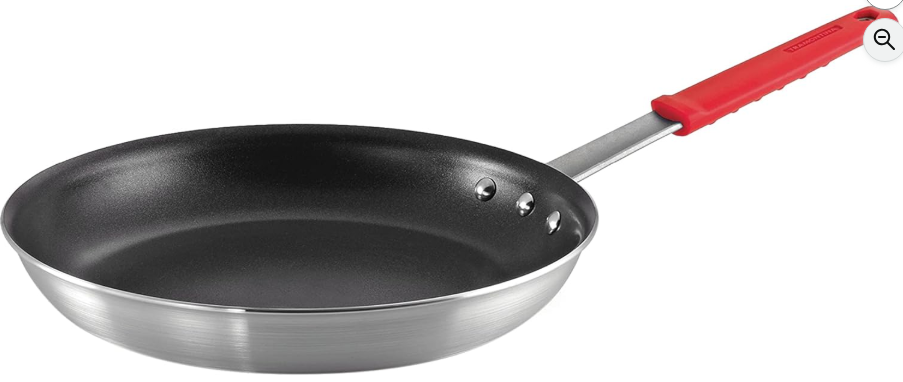
Product Description
Tramontina’s 10″ Professional ceramic skillet is built with heavy-gauge aluminum for excellent heat conduction, and its interior is coated with a smooth, PFOS/PFOA-free ceramic surface for easy food release. The pan’s design emphasizes practical performance — it heats quickly and evenly, and the coating makes cleanup simple. This model is dishwasher-safe, adding to its convenience for daily use.
Key Features
- Smooth, PFOS-/PFOA-free ceramic interior for healthy nonstick cooking (Amazon)
- Heavy-gauge aluminum body for fast, even heat distribution (Amazon)
- Ergonomic cast stainless-steel handle with stay-cool soft grip and hanging hole (Amazon)
- Oven safe for finishing dishes (Tramontina’s Ceramica line generally permits oven use) (Amazon)
- Dishwasher safe for easy cleanup (Amazon)
Pros
- High heat conduction: cooks evenly without hot spots
- Very sturdy and durable build
- Safe, cleaner cooking thanks to a toxin-free ceramic surface
- Good handle design that stays cool and is easy to grip
- Easy to clean, either by hand or dishwasher
Cons
- Aluminum base means it may not work on induction
- Heavier than ultralight pans because of its thick body
- Over time, ceramic coating may wear with metal utensils or rough cleaning
Recommendation
This pan is ideal for home cooks who want reliable performance at a reasonable price — especially if you cook frequently and value both safety and durability. It’s well suited for sautéing, frying, and one-pan meals.
5. GreenLife Soft Grip 12″ Ceramic Frying Pan
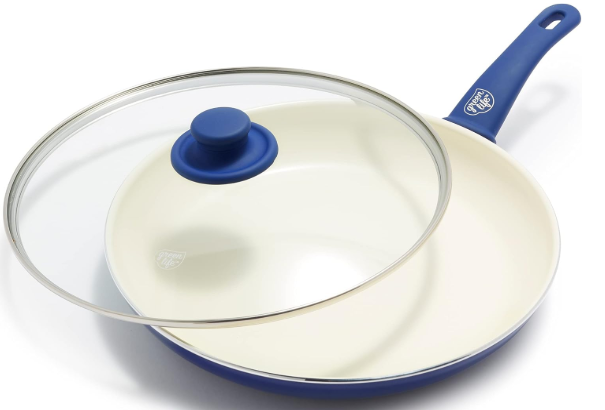
Product Description
The 12″ version of GreenLife’s Soft Grip ceramic series is tailored for larger meals, making it suitable for family-style cooking or when you need extra surface area. Like its smaller counterpart, this pan features a sand-derived ceramic nonstick coating that’s free from PFAS, PFOA, lead, and cadmium. The body is made from recycled aluminum, and the handle is constructed from soft-grip Bakelite to provide comfort and control. It’s reinforced at the base to avoid wobbling, and despite its size, it remains dishwasher-safe for convenient cleanup.
Key Features
- Spacious 12″ diameter for larger cooking tasks
- Non-toxic ceramic nonstick surface (Amazon)
- Recycled aluminum construction (Amazon)
- Soft-Grip Bakelite handle that remains cool to the touch (Amazon)
- Reinforced base for even heating and stability (Amazon)
- Dishwasher safe for easier maintenance (Amazon)
Pros
- Ample cooking area: perfect for big batches, stir-fry, or large proteins
- Safe and healthy coating for worry-free cooking
- Comfortable to handle despite the pan’s size
- Environmentally friendly build
- Good value for the surface area provided
Cons
- Larger size → heavier, may be cumbersome for some users
- Not suitable for induction cooktops (aluminum base)
- Ceramic coating longevity may suffer if overheated or used with rough utensils
Recommendation
Go for this 12″ GreenLife pan if you often cook family meals, sauté large amounts, or prefer a single large skillet. It’s a practical option that keeps cooking safe and cleaning relatively easy.
6. Tramontina Solara 10″ & 12″ Ceramic Frying Pan Set
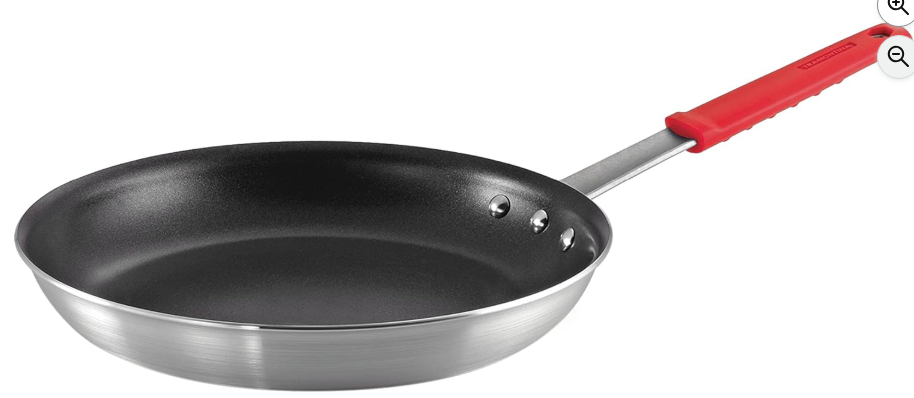
Product Description
This two-pan set from Tramontina includes a 10″ and a 12″ skillet, both featuring a ceramic nonstick interior and heavy-gauge aluminum bodies. The coating is designed for easy food release, reducing the need for excess oil. Both pans are oven- and dishwasher-safe, making them versatile and suitable for a wide range of cooking tasks. The set offers great value if you’re building out your ceramic cookware roster.
Key Features
- Includes both 10″ and 12″ frying pans for flexibility (Amazon)
- Ceramic nonstick coating (PTFE-free) for healthy release (Amazon)
- Heavy-gauge aluminum construction for rapid, even heat (Amazon)
- Dishwasher safe for both pans (Amazon)
- Oven safe for finishing or baking tasks (Amazon)
Pros
- Excellent value: two sizes for different cooking needs
- Even heat distribution for consistent results
- Nonstick performance without toxic chemicals
- Easy to clean and maintain
- Size versatility: use the smaller pan for daily tasks, and the large one for big meals
Cons
- Larger pan (12″) could be heavy when loaded with food
- Not induction compatible (aluminum base)
- Ceramic coating requires care (avoid metal utensils for longevity)
Recommendation
This set is a smart pick for someone upgrading their cookware: you get a small and large skillet at once, enabling more flexibility. It’s especially good if you want to ditch traditional nonstick pans and move to a healthier, ceramic-coated option without buying individually.
Final Thoughts
- If you want durability and serious performance, the OXO Enhanced 10″ is a top pick.
- For budget and toughness, go with the Blue Diamond 8″.
- For an eco-conscious, reliable daily pan, the GreenLife Soft Grip 10″ or its 12″ sibling is great.
- If you’re building up your kitchen, the Tramontina Solara 2-pan set gives you strong coverage for both small and large tasks.
Here’s a concise comparison table for the six ceramic-coated pans:
| Pan | Size(s) | Body Material | Oven Safe | Dishwasher Safe | Best For |
|---|---|---|---|---|---|
| OXO Enhanced | 10″ | Hard-anodized aluminum | ✅ (high temp) | ✅ | Versatile, daily frying + oven finishing |
| Blue Diamond | 8″ | Forged aluminum | ✅ / Broiler-safe | ✅ | Small meals, eggs, sautéing |
| GreenLife Soft Grip | 10″ | Recycled aluminum | ✅ (moderate) | ✅ | Low-fat cooking, eco-friendly use |
| Tramontina Professional | 10″ | Heavy-gauge aluminum | ✅ | ✅ | High heat cooking, sautéing reliably |
| GreenLife Soft Grip | 12″ | Recycled aluminum | ✅ (moderate) | ✅ | Large meals, stir-fries, family-sized cooking |
| Tramontina Solara Set | 10″ & 12″ | Heavy-gauge aluminum | ✅ | ✅ | Flexible pairing — small & large cooking tasks |
How to Use Ceramic-Coated Pans
Ceramic-coated pans are designed to make cooking easier and healthier, but using them correctly helps extend their lifespan and maintain their nonstick performance. Here’s how to get the best results:
1. Preheat Gently
Ceramic pans heat up quickly, so start on low to medium heat.
Avoid cranking the heat up immediately — this can cause coating damage over time.
2. Use a Small Amount of Oil
While ceramic pans offer excellent nonstick performance, a teaspoon of oil or butter can help improve browning and make cleanup easier.
Avoid using aerosol cooking sprays, as they leave sticky residue that can degrade the coating.
3. Allow the Pan to Heat Before Adding Food
For even cooking, let your ceramic pan warm up for 30–60 seconds before adding ingredients.
This prevents sticking and improves texture.
4. Use Proper Utensils
Always choose:
- Silicone utensils
- Wooden spoons
- Plastic or nylon spatulas
Avoid metal utensils, which can scratch or chip the ceramic coating.
5. Cook at Moderate Temperatures
Most ceramic coatings perform best at medium or medium-low heat.
This helps:
- Extend coating life
- Prevent discoloration
- Avoid warping the pan base
High heat should be used only when the manufacturer specifically states it’s safe.
6. Hand-Wash for Longest Life
Even if the pan is “dishwasher safe,” hand-washing with warm, soapy water protects the coating better.
Use a soft sponge — not steel wool or abrasive scrubbers.
7. Store Carefully
Avoid stacking ceramic pans directly on each other.
If you must stack them, place:
- A paper towel
- A pan protector
- A soft cloth
between pans to prevent scratches.
Safety Guide When Using Ceramic-Coated Pans
Ceramic cookware is generally safer than traditional nonstick pans, but proper use ensures both safety and long-lasting performance. Follow these safety tips:
1. Avoid Overheating
Overheating can:
- Discolor the ceramic surface
- Reduce nonstick performance
- Potentially cause coating damage
Stick to medium heat for most cooking tasks.
2. Never Heat an Empty Pan
Ceramic pans can heat rapidly.
If left empty on a hot burner, they may:
- Warp
- Split the coating
- Shorten overall lifespan
Always add a little oil, butter, or food before turning heat up.
3. Don’t Use Metal Tools or Sharp Objects
Metal edges can nick or chip the surface.
This won’t make the pan toxic, but it reduces effectiveness and may cause scratching that leads to food sticking.
4. Let the Pan Cool Before Washing
Sudden temperature changes (“thermal shock”) can:
- Warp the pan
- Crack the ceramic coating
Allow the pan to cool for 5–10 minutes before rinsing or washing.
5. Only Use Mild Detergents
Harsh chemicals or abrasive cleaners can erode the ceramic layer.
Use gentle dish soap and warm water.
6. Check Oven-Safe Temperatures
Not all ceramic-coated pans are oven-safe.
Always check the manufacturer’s rating — some pans max out at:
- 350°F (typical soft-grip handle pans)
- 450–600°F (metal-handle or pro-grade pans)
Avoid exceeding the recommended limit to prevent handle damage or loosening.
7. Avoid Long-Term Oil Build-Up
Sometimes oil residues bake onto ceramic surfaces over time.
To avoid that:
- Clean thoroughly after each use
- Use baking soda paste occasionally for deep cleaning (gentle scrubbing only)
8. Replace the Pan When Coating is Severely Damaged
Small scratches are normal, but if the coating begins:
- Peeling
- Flaking
- Showing large worn areas
…it’s time to replace it. A compromised coating loses nonstick ability and may trap bacteria.
Frequently Asked Questions (FAQs)
1. Are ceramic-coated pans safer than Teflon pans?
Yes. Ceramic-coated pans are generally considered safer because they are made without PFAS, PFOA, lead, or cadmium. They use a mineral-based coating that doesn’t release toxic fumes, even at higher temperatures.
2. How long do ceramic-coated pans last?
With proper care, a good-quality ceramic-coated pan can last 1–3 years. Longevity depends on usage, cleaning habits, and avoiding high heat or metal utensils.
3. Why is food starting to stick to my ceramic pan?
Over time, oil residue can build up or the coating can degrade. Try deep cleaning with warm water, mild detergent, and a baking soda paste. If sticking persists despite proper care, the coating may be worn out.
4. Can I use ceramic-coated pans on induction cooktops?
Not all ceramic pans are induction-compatible. Look for pans labeled “induction ready” with a magnetic stainless-steel base. Many aluminum-based ceramic pans won’t work on induction.
5. Are ceramic pans dishwasher safe?
Some are, but hand-washing is recommended for longer life. Dishwashers can dull the coating over time.
6. Can I sear meat on a ceramic pan?
Yes, but keep heat to medium or medium-high. Ceramic pans can sear well, but they should not be used on maximum heat for prolonged periods.
7. What utensils are best for ceramic coatings?
Use wooden, silicone, or nylon utensils. Avoid metal tools, as they can scratch or chip the coating.
8. Do ceramic pans need seasoning?
No. Ceramic pans are naturally nonstick and do not require seasoning like cast iron. However, using a tiny amount of oil can improve cooking results.
9. How do I prevent discoloration on my ceramic pan?
Avoid overheating, clean regularly, and don’t use aerosol sprays. If staining occurs, a baking soda paste and gentle scrubbing can help.
10. Can I store ceramic pans stacked?
Yes, but place a soft cloth, paper towel, or pan protector between them to prevent scratches.
Conclusion
Ceramic-coated pans have quickly become a go-to choice for home cooks who want a healthier, easier, and more enjoyable cooking experience. With their toxin-free coatings, fast heating, and naturally slick surfaces, they offer the perfect balance between performance and safety. Whether you’re frying eggs, sautéing vegetables, or preparing full family meals, a good ceramic pan can make all the difference.
Choosing the right one comes down to knowing your needs—whether it’s durability, eco-friendly materials, oven safety, or versatility. The products featured in this guide represent some of the best options available, offering strong nonstick performance and user-friendly designs.
With the proper care, ceramic-coated pans can serve you well for years. Follow the usage tips and safety guidelines outlined here to keep your cookware in top condition and enjoy smoother, healthier cooking every day.